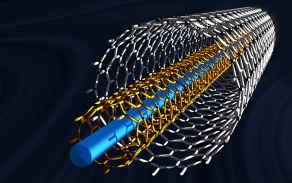Research Areas
Our faculty members and students are engaged in research in the areas of materials informatics, quantum flatland, quantum devices and quantum phenomena, and quantum circuits.

Materials Informatics: Designed Materials for Quantum Technology
Researchers in SEAS are applying their expertise in computational science to explore the predictive design of engineered materials, with targeted electrical, optical and thermal properties are optimized to support robust quantum phenomena. This effort is led by Krishna Rajan, Erich Bloch Chair and Empire Innovation Professor in the Department of Materials Design and Innovation (MDI), the leading proponent of the field of Materials Informatics. His research is centered on the application of information science and data intensive methodologies for the discovery, characterization and modeling of materials.
Krishna is joined by Quanxi Jia, Empire Innovation Professor and National Grid Professor of Materials Research in MDI, who also serves as scientific director of UB’s New York State Center of Excellence in Materials Informatics (CMI), and who has extensive experience in the synthesis of nanostructured materials. Olga Wodo, Kristofer Reyes, Scott Broderick and Bruce Pitman provide further expertise in “materials informatics”, applying high performance computing, statistics and machine learning for materials design and manufacturing.

Quantum Flatland: 2D Materials for Quantum Technology
Researchers across the Departements of Electrical Engineering and Materials Design and Informatics (Erik Einarsson), Mechanical and Aerospace Engineering (Shenqiang Ren), Chemical and Biological Engineering (Gang Wu) and Materials Design and Innovation ( Baishakhi Mazumder, Jung-Hun Seo and Fei Yao) are broadly involved in efforts to develop atomically-thin semiconductors for applications to nanoelectronics, quantum sensing, and energy storage and conversion.
A wide variety of material systems are investigated, including graphene and graphene oxide, transition-metal dichalcogenides and trichalcogenides, and boron nitride. Techniques are developed to synthesize and characterize these materials with atomistic resolution, allowing individual defects to be engineered for novel electronic and photonic devices.

Quantum Devices and Quantum Phenomena
To realize the full potential offered by the quantum realm, we are exploring how quantum phenomena can be exploited to enhance the performance of nanoscale devices. Jonathan Bird, Professor and Chair in the Department of Electrical Engineering, studies quantum “nonlocality” in nanoscale semiconductor devices, and learns how this can be exploited to implement new “quantum switches”. Vasili Perebeinos (Electrical Engineering) is an internationally-recognized expert who has undertaken pioneering theoretical studies of quantum processes in nanostructured materials, including carbon nanotubes, graphene, and transition-metal dichalcogenides. Huamin Li (Electrical Engineering) uses these materials to realize novel “tunnel transistors” whose performance is enhanced over existing silicon technology.